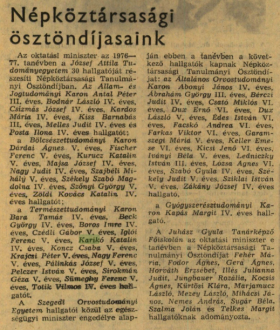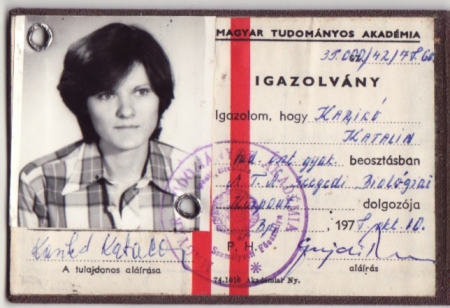

Katalin Karikó, an Alumna of the University of Szeged, is the Founder of the Most Promising Vaccine Development against the Coronavirus
A new type of messenger RNA based method is the most promising in coronavirus vaccine development.
Ilona Újszászi (SZTE): There is a race against the time among researchers for the development of the vacine for Covid19. As you can read on g7.hu one of the most promising new technologies for the rapid development of vaccines against the coronavirus and pandemic viruses in general was developed by a Hungarian researcher, Katalin Karikó from Kisújszállás, Szeged…She worked together with Drew Weissman from the United States at the University of Pennsylvania and the related patent is also listed by the two – says g7.hu . If one browses among the digitalized 'Szegedi Egyetem' - the student newspaper of the University of Szeged - from 1975, 1976, 1977, they can read that Katalin Karikó won the most significant Hungarian student support/scholarship at that time, the People's Republic Study Scholarship. How did this scholarship affect your life?
Katalin Karikó (KK): The Republic Study Scholarship meant financial support, as I remember it was 1000 HUF per month for our excellent academic results. I don’t think it had been widely known who benefited from it. But I can see in the copy of the newspaper article that Ferenc Nagy, a biology student who is now an academician and the Director General of the Biological Research Centre, Szeged, and József Pálinkás, a physics student who was the president of the Hungarian Academy of Sciences, and Minister of Education was also awarded in 1975.

Encounter with viruses
SZTE: Graduated from the University of Szeged You accepted a position at the Biological Research Centre, Szeged (BRC, Szeged) with an academic scholarship, and worked there until 1985, when you were 30 years old. What was in your focus? How far has it come in developing messenger ribonucleic acid (messenger RNA) Until 1985?

KK: I started working in the nucleotide chemistry laboratory of the Institute of Biophysics of the BRC in 1978 as a scholarship holder of the Hungarian Academy of Sciences, under the supervision of Jenő Tomasz, an organic chemist. At that time, only very short pieces of RNA of 3-4 nucleotides were possible to synthesize, and we tested these molecules for antiviral activity. The so-called mRNA encoding the protein is much longer, containing hundreds and thousands of nucleotides, respectively. At that time, we could not make mRNA because the enzyme, RNA polymerase, which we use today, was not yet available. The significance of my work in Tomasz's lab today is that I started working with viruses there and first used a modified nucleoside - cordycepin.
SZTE: Why could this method result in the quick production of the vaccine against the novel coronavirus? At all: what is the main difference between the different approaches of vaccine developments against the coronavirus?
KK: Vaccines based on the mRNA technology are easy and quick to produce. It is important to emphasize, that this vaccines do not contain the complete gene sequence of the virus, therefore they are fully safe to use, do not cause infection. News went around about the vaccine of the Moderna company, that the first human trials with their vaccine just started 62 days after the whole genome sequence of the virus was revealed. According to the WHO's data from the 26th of March 2020, currently there are 54 vaccines in development. In most of the vaccines the protein which triggers the immune response is coded by mRNA or plasmid DNA, or a section of a gene transferred to a non-pathogen virus. Others try a different approach by using the protein itself or the attenuated virus. But these vaccines need more time to be developed and used.
SZTE: What is the most significant difference between coronavirus and influenza virus from a biologist’s point of view?
KK: The genome of the coronavirus is a very long mRNA, while the influenza’s RNA consists of 8 smaller particles, which might alternate with other animals’ influenza virus.
SZTE: How do synthetic mRNA activate the immune cells?
KK: The mRNA made with a modified nucleoside, namely 1-metilpseudouridine, is not immunogenic, meaning that the activation is possibly carried out by the lipid nanoparticle (LNP) covering the mRNA. The function of this LNP is to protect the mRNA from RNase, the ribonuclease breaking down ribonucleic acid. The modified mRNS’s immune effects on the field of immune vaccines have been proven by my colleague, Norbert Pardi, who works at University of Pennsylvania and also received his degree in Biology in 2004 at the University of Szeged.
SZTE: You once mentioned to g7.hu that you are happy, because “… it is not common for a researcher to see her own invention make it to the patient’s bed from the laboratory desk”. When do you think the coronavirus vaccine will be finished and sold in pharmacies?
KK: If all goes according to our plans and wishes, the mRNA vaccine of Moderna will be available for everyone from the beginning of 2021.
Talent care in the past and present
SZTE: How does your research connect to your Alma Mater? What kind of memories do you have about the university where you obtained your degree in 1978?
KK: The 5 years I spent at the University of Szeged were the happiest years of my life. We studied a lot, participated in lectures and practices from early morning till late evening, and during summer months we had field trips. We had excellent teachers and lecturers, my most memorable tutors were László Orosz teaching Genetics, Gábor Bernáth teaching Organic Chemistry, Imre Pávó teaching Mathematics and Lajos Ferenczy teaching Microbiology. We also had a lot of fun in our leisure time as it was the peak of the disco era… The Herman Dormitory in Újszeged, where I lived had a very active social life…
SZTE: You defended your doctoral dissertation at The József Attila University of Szeged (JATE), you were inaugurated as a doctor in 1983. What is your opinion about the functions and possibilities of talent care today and back in the day?
KK: Back in the 1970’s the JATE organised preparatory camps for those underprivileged high schools students who wanted to pursue their university studies in Szeged. I participated in two of these university preparatory programmes during the summer of 1972 and in January 1973. I believe these preparatory courses contributed in a great deal to my successful application and cope with all the challenges later on. I’m not familiar with the current ways of talent care in Szeged.
SZTE:
Your daughter, who was also born in Szeged, is very talented. I’ve read that Susan Francia is a two-time Olympic champion and five-time world champion in rowing is US colors. How do you look back at Szeged today?
KK: I have a lot of beautiful memories of Szeged. The already mentioned happy university years, in 1977, during which I met my husband, Béla Francia. We got married at the council-house in Szeged, our daughter Zsuzsi was also born and went to nursery in Szeged. We lived in Tarján, later in Makkosháza (districts of Szeged). Whenever we visit home, we always go to see Szeged and the most memorable places of our lives there.
Focus on the cure of genetic deficiency diseases
SZTE: On the largest social network, I have come across some of the common acquaintance related to the SZTE. How is your relationship today with the University of Szeged?
KK: Unfortunately, I do not have professional relationships.
SZTE: At the moment, you are working in Germany for BioNTech, a company that is revolutionizing anti-cancer drug development. As a researcher, what topics are you dealing with lately?
KK: Developing a cure for various genetic deficiency diseases using mRNA is one of our tasks. These, for the time being, apply to deficiency diseases where the treatment is successful by delivering the mRNA encoding the missing protein to the liver. The therapeutic use of antibody-encoding mRNA is another important area of our research. I have been studying the literature on neurodegenerative diseases for decades, I would very much like to understand the cause of their formation and develop a therapy for it.
SZTE:If we look from the present to the future: what is the main consequence or lesson of the coronavirus pandemic?
KK: I hope that decision-makers, business people and politicians all over the world realize that much more of the budget must be focused on and given to education, science and health! That respect and material esteem are due to teachers who teach the next generation, researchers that are obsessed with finding solutions to eternal problems, the doctors and the nurses who save us at the risk of their lives. This way if another virus sweeps through the world, we will be much more prepared to repel and bounce back from the attack faster.
SZTE Info





